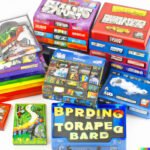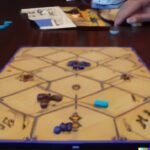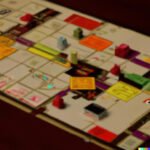Are you a fan of thrilling adventures, strategic thinking, and immersive storytelling? Look no further than the classic dungeon board game. These games have been captivating players for decades, taking them on epic quests filled with danger, treasure, and endless possibilities.
A classic dungeon board game is a tabletop game where players assume the roles of heroes exploring treacherous dungeons. They must navigate through winding corridors, encounter fearsome monsters, overcome traps, and ultimately claim the coveted treasures that lie within. The game is played on a board representing the dungeon, often accompanied by various cards, miniatures or tokens to enhance the gameplay experience.
The appeal of classic dungeon board games lies in their ability to transport players into richly detailed fantasy worlds. Each game offers a unique narrative experience as players make choices that impact their journey and discover hidden surprises along the way. Additionally, these games foster social interactions as friends come together to collaborate or compete against each other in an epic battle of wits and strategy.
Whether you are just discovering the world of classic dungeon board games or have already fallen under their spell, this article will guide you through everything you need to know about these exciting games. From their history and essential components to strategies for success and expansion possibilities, prepare yourself for a thrilling adventure into the enduring charm of classic dungeon board games.
History of Classic Dungeon Board Games
The history of classic dungeon board games is a rich and diverse one, spanning several decades and evolving with the advances in technology and game design. From the originals that laid the foundation for this genre to the modern adaptations that continue to captivate players today, let’s explore the intriguing journey of these beloved games.
The Birth of Classic Dungeon Board Games
Classic dungeon board games have their roots in tabletop role-playing games (RPGs), such as Dungeons & Dragons, which gained popularity in the 1970s. These early games provided players with immersive experiences, allowing them to create and navigate through fantastical dungeons filled with monsters, treasures, and epic quests.
One notable example is “Dungeon.” by David R. Megarry, released in 1975. This game introduced many of the elements that would become staples in classic dungeon board games, including a modular board representing different levels of a dungeon and various character classes.
The Evolution of Classic Dungeon Board Games
As technology advanced, so did the world of classic dungeon board games. In the 1980s and 1990s, popular games like HeroQuest and Advanced HeroQuest introduced more complex mechanics and storylines.
In recent years, classic dungeon board games have experienced a renaissance with modern adaptations that incorporate innovative gameplay mechanics and stunning components. Games like Gloomhaven and Descent: Journeys in the Dark have raised the bar for immersive storytelling and strategic depth within this genre.
Furthermore, digital adaptations like video game versions or companion apps have brought classic dungeon board games to new audiences while enhancing gameplay experiences through interactive features.
Legacy in Classic Dungeon Board Games
The legacy left by classic dungeon board games can be seen in many aspects of modern gaming culture. These games have inspired countless titles across various platforms, from computer RPGs to video game franchises like The Elder Scrolls series.
Additionally, classic dungeon board games have influenced literature and movies, showcasing their enduring appeal. Iconic characters and themes from these games have made their way into novels, as well as popular films like the Lord of the Rings trilogy.
Must-Have Components
A classic dungeon board game is made up of several essential components that enhance the gaming experience and draw players into the immersive world of adventure and strategy. These components are crucial in creating a dynamic and engaging gameplay. Here are some must-have components that you can expect to find in a classic dungeon board game:
- Board: The board is the central element of any classic dungeon board game. It serves as the setting for the game and provides a visual representation of the labyrinth-like dungeons, corridors, and rooms that players will explore. The design of the board can vary from game to game, but it typically features a grid or specific paths that players can move along.
- Miniatures: Miniatures are small figurines that represent characters, monsters, or other entities within the game. They add a visual element to the gameplay, allowing players to physically see their characters come to life on the board. Miniatures come in various shapes, sizes, and levels of detail, making them collectible and highly prized by many enthusiasts.
- Cards: Cards are an integral part of classic dungeon board games as they provide players with additional resources, abilities, or obstacles throughout the game. These cards can include items, spells, traps, encounters, or events that players can use strategically to gain an advantage over their opponents or overcome challenges within the dungeon.
- Dice: Dice play a vital role in determining outcomes such as combat results, skill checks, or random events in a classic dungeon board game. Players roll dice to determine success or failure when attacking enemies or attempting actions such as opening chests or disarming traps. Different types of dice may be used depending on the complexity of the game system.
- Rulebook: A rulebook is an essential component that outlines all the rules and mechanics needed to play the classic dungeon board game correctly. It provides instructions on how to set up the game, explanations of each component’s purpose and usage, and the steps to follow during gameplay. The rulebook ensures fairness and consistency among players and helps resolve any disputes or uncertainties that may arise.
These must-have components are crucial in creating a cohesive and engaging experience in a classic dungeon board game. Each component serves a unique purpose and contributes to the overall gameplay mechanics, providing hours of entertainment for both casual gamers and enthusiasts alike. Whether it’s exploring intricate dungeons, battling fearsome monsters, or outsmarting opponents, these essential elements make classic dungeon board games a captivating adventure for players of all ages.
Getting Started
Gather your materials
Before you can dive into the exciting world of classic dungeon board games, it’s important to gather all the necessary materials. Typically, you will need a game board, player pieces, dice, cards for various purposes (such as character abilities or treasure), and a rulebook.
Each game will have its own specific components, so be sure to check the instructions included with your particular game. Additionally, it may be helpful to have a pen and paper on hand for keeping track of scores or jotting down important details.
Set up the game board
Once you have all the materials ready, it’s time to set up the game board. Follow the instructions provided in the rulebook to assemble any necessary pieces or tiles, such as walls or doorways. Place any cards or tokens in their designated spaces on the board. Ensure that each player has their own designated starting area and place their corresponding player pieces there.
Familiarize yourself with the rules
Before starting gameplay, take some time to read through the rulebook thoroughly. Familiarize yourself with how turns are taken, what actions can be performed by players during their turn, and any special rules or conditions that apply. Understanding these rules will help ensure a smooth and enjoyable gaming experience for everyone involved.
Begin playing
Once everything is set up and you feel comfortable with the rules, it’s time to begin playing. Typically, players take turns in clockwise order around the table. During your turn, you may move your character piece across the board exploring different rooms or areas within the dungeon. You may encounter enemies or treasures along the way which can impact your gameplay strategy.
Remember that communication and collaboration are key elements in many classic dungeon board games. Working together with other players can increase your chances of success and make for a more engaging experience overall. Don’t forget to have fun and immerse yourself in the adventure of the game.
Strategies and Tactics
One of the most exciting aspects of playing a classic dungeon board game is the opportunity to outsmart your opponents. While luck does play a role, employing effective strategies and tactics can greatly increase your chances of emerging victorious. In this section, we will explore some tips and tricks that will help you dominate the game and leave your opponents in awe.
First and foremost, it is crucial to have a solid understanding of the game’s mechanics and rules. Familiarize yourself with the various actions that can be taken during each turn, as well as any special abilities or powers that may be at your disposal. This knowledge will allow you to make informed decisions and leverage them to gain an advantage over your opponents.
Another important strategy is proper resource management. Many classic dungeon board games involve collecting resources such as gold, weapons, or magic items. It is essential to prioritize which resources are most valuable for your overall strategy and allocate them wisely. For example, if obtaining powerful weapons is crucial for defeating monsters, you may want to focus on acquiring gold through various means to purchase them.
Furthermore, it is often beneficial to plan ahead and think several steps ahead of your opponents. Anticipating their moves or predicting their intentions can give you an edge. Pay attention to their choices and movements on the board; this can provide valuable insights into their strategies and allow you to adjust yours accordingly.
Lastly, do not underestimate the power of teamwork in some classic dungeon board games. While it may be a competitive game where only one person emerges victorious, forming alliances or temporary partnerships with other players can be advantageous in certain situations. Cooperating with others can help take down formidable enemies or achieve mutual objectives more efficiently.
Expansions and Variants
Classic dungeon board games have captivated players for decades with their immersive gameplay and rich storytelling. One of the reasons for their enduring popularity is the constant release of expansions and variants, which offer players new ways to experience and enjoy the game. In this section, we will take a closer look at the vast world of classic dungeon board game enhancements, including expansions, variants, and custom modifications.
Expansions are add-ons to the base game that introduce new content such as characters, quests, items, or even entire new storylines. These expansions not only extend the replayability of the game but also deepen the overall gaming experience. For example, an expansion may introduce powerful enemy bosses or challenging dungeons that require advanced strategies to overcome. Some expansions also come with additional components like miniatures or cards that enhance the visual aspect of the game.
On the other hand, variants are alternate versions or rule adjustments that modify certain aspects of gameplay to provide different challenges or gameplay experiences. Some variants may focus on cooperative play, allowing players to work together against AI-controlled enemies instead of playing competitively against each other. Other variants may introduce role-playing elements where players can develop their character’s abilities or make choices that affect the outcome of their quests.
In addition to official expansions and variants released by game publishers, many classic dungeon board games have vibrant communities of enthusiasts who create their own custom modifications. These fan-made enhancements can range from homebrewed expansions with new maps and scenarios to customized miniatures and unique rulesets. These contributions often foster creativity within the community and bring fresh ideas into classic dungeon board gaming.
| Game Title | Expansion/Variant Title |
|---|---|
| Descent: Journeys in the Dark | The Chains That Rust – Expansion |
| Gloomhaven | Frosthaven – Standalone Game with New Campaign |
| Zombicide: Black Plague | Wulfsburg – Expansion with New Necromancer Enemies and Heroes |
Community and Events
Classic Dungeon Board Games have a vibrant and thriving community that adds to the overall appeal of these games. The social aspect of playing these games with fellow enthusiasts is an integral part of the experience. From local meetups to large-scale conventions, there are numerous opportunities for players to connect and share their love for classic dungeon board games.
One of the key ways enthusiasts come together is through gaming clubs and meetup groups. These groups provide a space where players can gather regularly to enjoy their favorite dungeon board games. It is a chance for like-minded individuals to bond over their shared passion, learn from each other’s strategies, and form connections within the community. Some clubs even organize tournaments or competitions, adding a competitive element to the social aspect of classic dungeon board games.
In addition to local meetups, conventions dedicated to classic dungeon board games are held worldwide. These events bring together players from all walks of life who share an enthusiasm for these games.
At these conventions, attendees can explore vendor booths, try out new game releases, participate in tournaments, attend workshops or seminars hosted by industry experts, and meet game designers. Such events offer a unique opportunity for gamers to engage with both the creators and fans of classic dungeon board games, fostering a sense of camaraderie and excitement within the community.
For those unable to attend physical events, online communities provide another avenue for connecting with fellow enthusiasts. Forums and social media groups dedicated to classic dungeon board games allow players from around the world to discuss strategies, ask questions, and share their experiences. This online presence further strengthens the bond among fans and allows for continuous engagement in conversations related to gameplay mechanics, expansions, reviews, and more.
Overall, the community surrounding classic dungeon board games plays a crucial role in enhancing the enjoyment and fulfillment derived from these engaging tabletop experiences. Whether it’s through local meetups or large-scale conventions, connecting with others who share a similar passion fosters a sense of belonging within the community. These social interactions not only provide opportunities to learn and grow as players but also create lasting friendships that extend beyond the gaming table.
Classic Dungeon Board Games in Popular Culture
Classic dungeon board games have had a significant impact on popular culture, influencing various forms of media such as movies, literature, and video games. These games have created captivating narratives, challenging gameplay mechanics, and imaginative worlds that continue to captivate audiences across different mediums.
One area where classic dungeon board games have made their mark is in the world of literature. Many authors have drawn inspiration from these games to create their own fantasy novels filled with adventure and danger. Novels like “The Lord of the Rings” by J.R.R. Tolkien and “The Wheel of Time” series by Robert Jordan showcase immersive worlds and epic quests that parallel the experience found in classic dungeon board games.
In addition to literature, classic dungeon board games have also influenced the creation of movies and television shows. The popularity of tabletop gaming has led to an increased interest in adapting these games into live-action or animated entertainment. From movies like “Jumanji” to TV shows like “Stranger Things,” classic dungeon board game elements such as exploration, teamwork, and overcoming challenges form the basis for thrilling storytelling on the big screen.
Furthermore, classic dungeon board game mechanics and concepts often find their way into video game adaptations. The interactive nature of video games allows players to immerse themselves in virtual dungeons filled with monsters, treasures, and complex puzzles. Titles like “Dungeons & Dragons” inspired iconic video game franchises such as “Baldur’s Gate” and “The Elder Scrolls,” showcasing the enduring influence of these board games in shaping digital adventures.
| Medium | Examples |
|---|---|
| Literature | “The Lord of the Rings” by J.R.R. Tolkien |
| Movies | “Jumanji” |
| Video Games | “Baldur’s Gate” |
Classic dungeon board games have become an integral part of popular culture, inspiring and influencing various forms of media. Whether it is through the creation of immersive novels, exciting movies, or captivating video games, these board games continue to shape the way we experience fantasy adventures and embark on epic quests.
Conclusion
In conclusion, classic dungeon board games have a timeless charm and enduring appeal that continue to captivate players of all ages. These games hold a special place in the hearts of many enthusiasts, whether they are long-time fans or newcomers to the world of tabletop gaming. The rich history and evolution of these games have paved the way for countless adaptations, expansions, and variants that keep the genre fresh and exciting.
One of the reasons why classic dungeon board games remain popular is their ability to transport players into fantastical worlds filled with adventure, mystery, and strategic challenges. They provide a unique opportunity for friends and family to come together and immerse themselves in cooperative or competitive gameplay, fostering memorable moments and strengthening bonds. The thrill of exploring treacherous dungeons, battling fearsome monsters, and discovering hidden treasures keeps players engaged and coming back for more.
Moreover, classic dungeon board games have had a lasting impact on popular culture. They have inspired movies, literature, and even video games. Many successful franchises owe their roots to these timeless classics. Their influence can be seen in the storytelling elements, character archetypes, and immersive worlds present in other forms of media. Classic dungeon board games have truly left an indelible mark on our collective imagination.
While technology continues to advance at a rapid pace, there will always be a place for classic dungeon board games in our lives. Their physicality and tangible components offer a tactile experience that cannot be replicated by digital alternatives. The social aspect of gathering around a table with friends or family creates memories that last a lifetime.
In this era when screens dominate our attention, classic dungeon board games serve as a refreshing reminder of simpler times when face-to-face interactions were cherished. So whether you are drawn to the strategic challenges or simply want to embark on an epic adventure with loved ones by your side, classic dungeon board games will always be there to provide endless enjoyment.

I love playing all kinds of games – from classics like Monopoly to modern favourites like Ticket to Ride.
I created this blog as a way to share my love of board games with others, and provide information on the latest releases and news in the industry.





